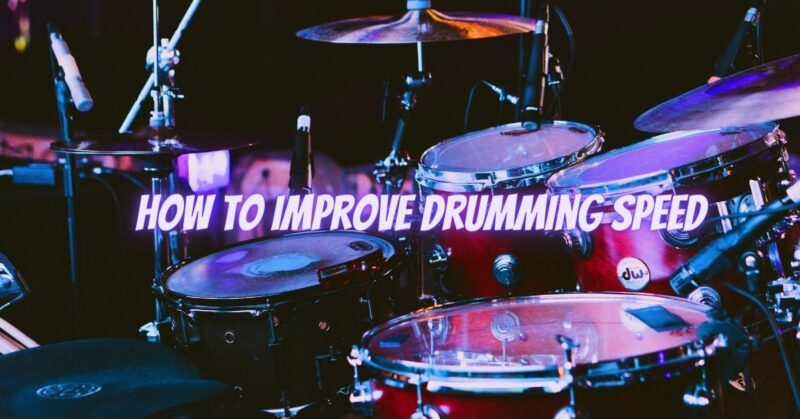Drumming speed is an essential skill that allows drummers to play intricate patterns, execute rapid fills, and maintain a solid groove. Building speed on the drums requires a combination of technique, control, and focused practice. In this article, we will explore various techniques and exercises that can help you improve your drumming speed and build dexterity, precision, and fluidity in your playing.
- Develop Proper Technique: Efficient technique is the foundation for developing speed on the drums. Focus on the following aspects of your technique to optimize your playing:
a. Grip: Use a relaxed and balanced grip on the drumsticks. Avoid unnecessary tension in your hands, wrists, and arms. Experiment with different grip styles, such as matched grip or traditional grip, to find what works best for you.
b. Fulcrum: Establish a solid fulcrum, which is the point of contact between your thumb and index finger on the drumstick. This allows for controlled rebound and facilitates faster stick movement.
c. Finger Control: Develop finger control to maximize speed and efficiency. Practice exercises that isolate finger movements, such as playing single strokes using mainly your fingers.
- Practice with a Metronome: Playing at a consistent tempo is crucial for building speed. Use a metronome during your practice sessions to maintain a steady beat. Start at a comfortable tempo and gradually increase the speed in small increments. Focus on accuracy and control, ensuring that each stroke is clear and even. As you become more comfortable, challenge yourself by pushing the tempo gradually.
- Focus on Hand and Foot Independence: Developing hand and foot independence is vital for executing complex drumming patterns at higher speeds. Practice exercises that involve different rhythms and accents between your hands and feet. Start with simple patterns and gradually increase the complexity as your coordination improves. For example, practice playing a basic rock beat with accents on different drum and cymbal surfaces while maintaining a consistent bass drum pattern.
- Utilize Rudiments and Patterns: Drum rudiments are not only essential for building technique but also for improving speed. Incorporate rudiments like single strokes, double strokes, paradiddles, and flam accents into your practice routine. Start at a comfortable tempo, focusing on clean and controlled execution. Gradually increase the speed while maintaining precision and clarity. Practice these rudiments on various surfaces of the drum kit to develop speed and control across different instruments.
- Implement Speed Exercises: There are several speed exercises that can help improve your drumming speed. Here are a few examples:
a. Single Stroke Roll: Practice playing fast and controlled single stroke rolls, gradually increasing the speed while maintaining accuracy and consistency.
b. Double Stroke Roll: Develop speed and fluidity in your double stroke roll by practicing with a metronome at various tempos.
c. Stick Control: Work on exercises from the Stick Control book by George Lawrence Stone. These exercises involve various combinations of single strokes, double strokes, and accents, helping to build speed and control.
- Focus on Slow Practice: Counterintuitively, practicing at slower tempos can significantly improve your speed in the long run. Slow practice allows you to focus on accuracy, control, and technique. Pay attention to the details of each stroke, ensuring that you are executing them cleanly and efficiently. Gradually increase the speed as your control and comfort improve.
- Stay Relaxed and Stay Consistent: Maintaining a relaxed playing technique is crucial for building speed. Tension in your muscles can hinder fluidity and control. Focus on staying relaxed, especially in your wrists and fingers. Consistent and focused practice is key to improving speed. Dedicate regular practice sessions to speed development, even if it’s just a few minutes each day. Consistency will yield better results than sporadic, longer sessions.
Conclusion: Improving drumming speed requires patience, dedication, and focused practice. By developing proper technique, practicing with a metronome, focusing on hand and foot independence, utilizing rudiments and patterns, implementing speed exercises, and staying consistent, you can gradually build your speed and control on the drums. Remember to start at a comfortable tempo and gradually increase the speed, always prioritizing accuracy and clarity. With regular practice and a systematic approach, you’ll see noticeable improvements in your drumming speed over time.


